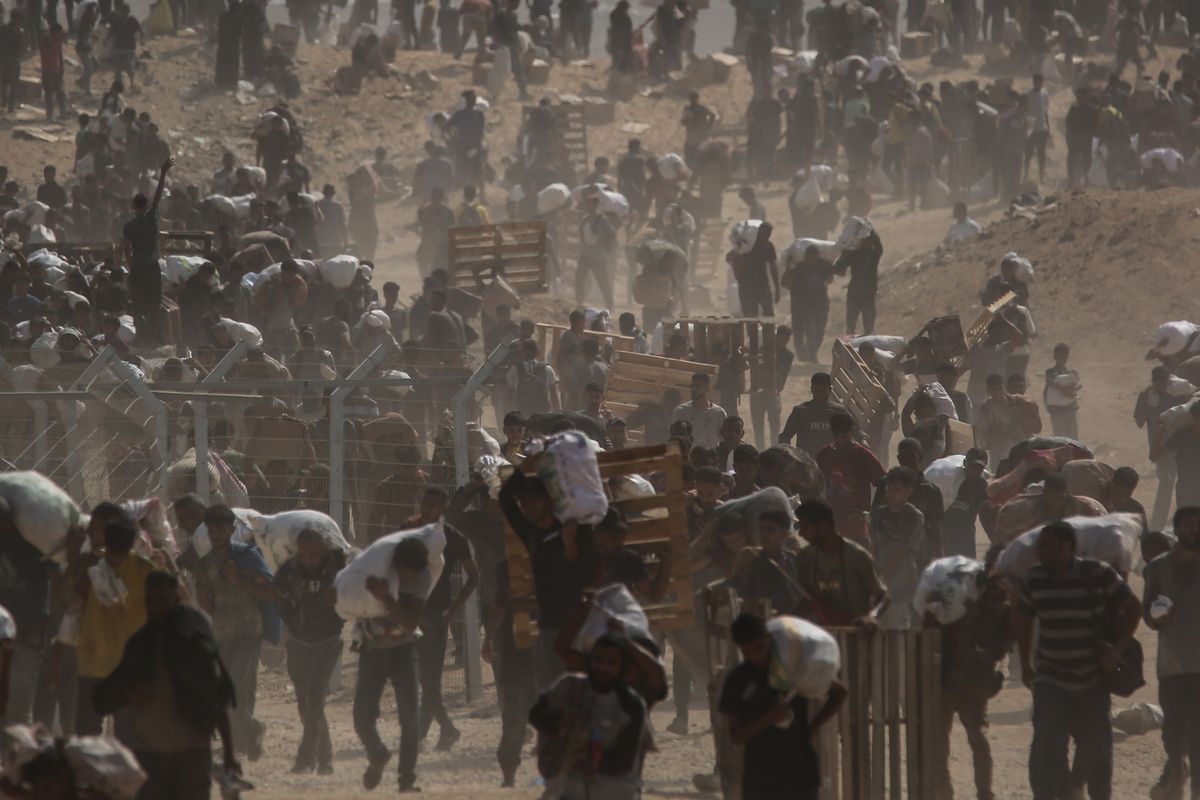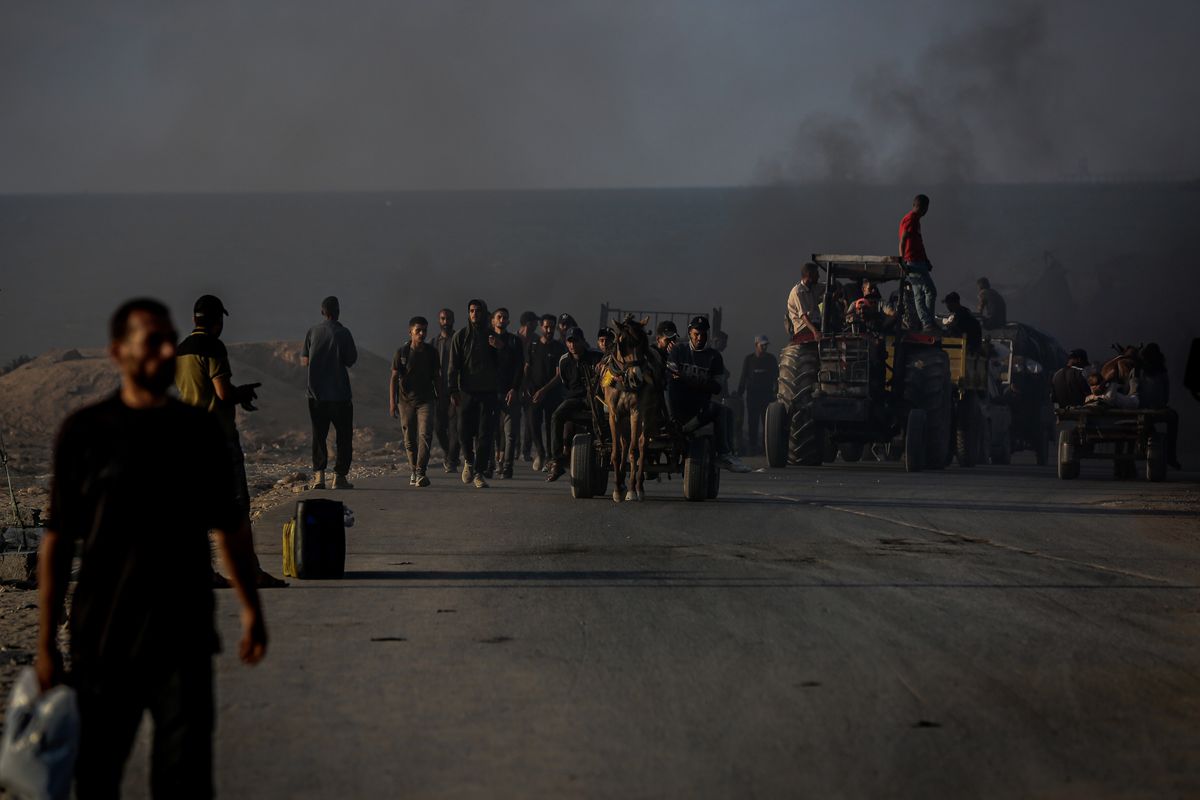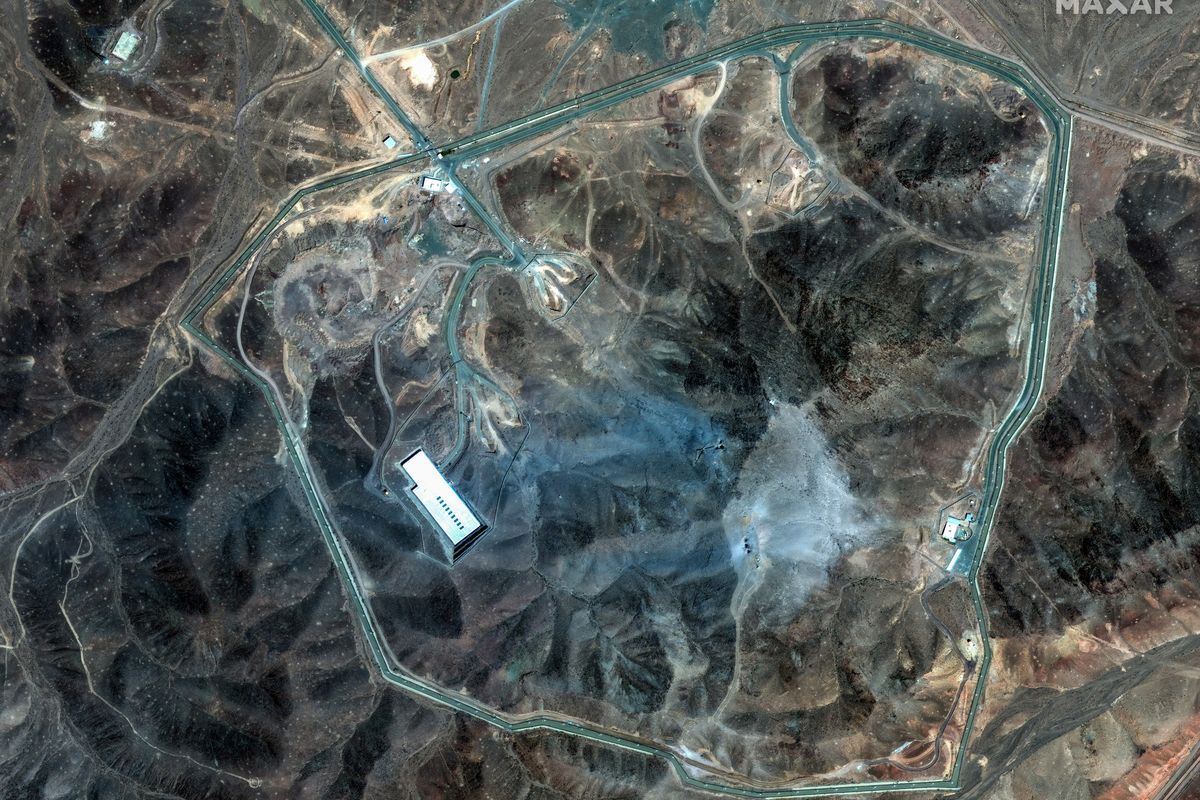SUBSCRIBER+EXCLUSIVE INTERVIEW – Last week, just days after the U.S. retaliated - in what it called the ‘beginning’ of a multi-tiered response - against Iranian-backed proxy groups for the killing of three US service members in Jordan, Iranian-backed Houthis targeted two ships in the Red Sea with ballistic missile fire.
The Houthis have remained defiant and are continuing to launch attacks against vessels even after a series of recent raids carried out by the US and the UK targeting missile launchers in Yemen.
Houthi leaders say 17 fighters have been killed in U.S. and UK-led strikes to date, as the group continues its Red Sea attacks in what it calls retaliation for Israel’s war against Hamas, the war that followed a brutal terrorist attack launched by Hamas inside of Israel last October.
Richard Meade, editor-in-chief of Lloyds List told CNN that “there has been an ‘almost wholesale exodus’ of larger container ships from the Red Sea and adjoining Suez Canal.
Last Wednesday, a commander of Kataib Hezbollah, an Iranian-backed group operating in Iraq, was killed in Baghdad. In a statement, the Pentagon said that U.S. “forces conducted a unilateral strike in Iraq in response to the attacks on U.S. service members, killing a Kataib Hezbollah commander responsible for directly planning and participating in attacks on U.S. forces in the region.”
Meanwhile, analysts are paying close attention to what could happen next.
Two Iranian ships, the Behshad and the Safiz are suspected of providing intelligence to the Houthis, aiding attacks against commercial and U.S. vessels in the Red Sea. An unnamed U.S. Official and a source identified as a U.S. Congressional aide told NBC News that the Behshad “provides electronic intelligence to the Houthis, enabling them to spot and target vessels in the Red Sea region.”
Just two days after the US attacks against Iranian proxies on February 2, Iran issued a stern warning not to attack the ships. But with Houthi attacks continuing in the Red Sea, what happens next?
“If you're Iran, you've got to be wondering what's going to happen to those naval ships. You've got the Behshad, the alleged Iranian spy ship that's in the Gulf of Aden and the Saviz, which is further east. I would suspect Iran is going to be watching these and likely moving a frigate or two nearby just to make sure that nothing happens there,” Norm Roule, former National Intelligence Manager for Iran (NIM-I) at the Office of the Director of National Intelligence (ODNI) told The Cipher Brief.
We spoke with Roule about Iran’s response to the U.S. attacks against targets in Syria and Iraq on February 2 and asked him to help provide some context on the question of escalation in the region. Our interview has been lighted edited for length and clarity.
Norm Roule, Former NIM-I, ODNI
Norman T. Roule is a geopolitical and energy consultant who served for 34 years in the Central Intelligence Agency, managing numerous programs relating to Iran and the Middle East. He served as the National Intelligence Manager for Iran (NIM-I) at the ODNI from 2008 until 2017 where he was the principal Intelligence Community (IC) official responsible for overseeing all aspects of national intelligence policy and activities related to Iran.
The Cipher Brief: What would keep the U.S. from striking the two Iranian ships that it believes are providing intelligence to the Houthis that is aiding in their attacks on Red Sea vessels?
Roule: It's easy to say that we should strike all of Iran's capabilities in the area, and that includes its personnel and its locations. While that's easy to say, it raises issues, such as if the United States starts attacking the ships of a sovereign country in international waters, that sets interesting precedents. And we certainly have causes and reasons to do that, but other people may think they have causes and reasons to do that too, and that usually is getting into active war territory. I'm not saying that these ships won't have bad luck. That's possible. The Savaz allegedly ran into a mine that someone placed in front of it when it was in the Red Sea a while back, and perhaps something like that would happen. But I think the United States will want to be careful about transforming the Arabian Sea, the Gulf of Aden, the Gulf of Oman which are vast bodies of water, into a less predictable zone for trade and transportation without some serious strategic gain by its operations.
Let's imagine we take out the Behshad. How does that significantly change the battle space? Would the Iranians replace it the next day with another spy ship but put a frigate next to it to say, "Feel free to touch it. We'll go to war." You could see this playing out in interesting ways.
I think for the United States as a whole, the goal is going to be pound the militias, pound the Iraqis, take out some of their leaders, and then see how that message spreads through the region. You're getting at this point - not only into the ‘what’ we're going to hit and ‘how’ - but also the ‘when’.
If we look at the how, we're watching the B-1 be employed, the US has a submarine in the area, they have a number of highly sophisticated, extraordinarily capable pieces of equipment for which Iran and its proxies have no defense or capacity to operate against.
That itself is messaging. It's also a message to US partners in the region, ‘This is what we will bring to the table in a conflict of this nature. The US would bring this to the table in a conflict protecting your equities as well.’ But I think as you're looking at this, it's going to take a while to play out.
You're going to want to look at the intelligence assessment from the days after the strikes to see who's moving in the area and what actors are responding.
It's not just for the President anymore. Are you getting your daily national security briefing? Subscriber+Members have exclusive access to the Open Source Collection Daily Brief, keeping you up to date on global events impacting national security. It pays to be a Subscriber+Member.
The Cipher Brief: What other targets might the U.S. be considering as part of its multi-tiered response for the killing of three service members?
Roule: If the US is interested in taking apart infrastructure, the infrastructure is easiest taken apart if you focus on a weapons site or maybe a training area. The US has been there for a number of years. I've read in the newspaper that we have something called satellites and drones, and I've read in the newspaper that we have an intelligence community. I would presume that we have a rather detailed understanding of what these sites are like and where they are. And the US has hit a number of them in the past, which indicates they are aware of these locations and aware of their relationship to Iran.
But I would also look for compounds that house key individuals, compounds that house sensitive equipment that isn't necessarily stored at a traditional weapons depot, intelligence coordination, and fusion centers set up between the revolutionary guard and its operatives amongst the various militias.
Remember, we're looking at a militia dynamic that is not monolithic. What that means is if you have good intelligence and very experienced people - and we have those within the US intelligence and military community – you're going to be watching to shape a dynamic and to build cracks and fissures within a polity of different tribes, different actors, different political players. Iran is a long ways off and its proxies are going to see it's not able to do much to protect them.
The Cipher Brief: Do you anticipate that a strong US multi-tiered response could result in any significant forced posture changes by the US in either Syria or Iraq?
Roule: The easy answer is to say that will be determined based on the intelligence assessments conducted after the initial bombings. I think it's possible for us to say that the US footprint within the region is already so considered and so well organized that we are probably positioned with only minor adjustments to take care of whatever comes at us. Remember, the US has personnel in Kuwait, Bahrain, the Emirates. We already have a robust posture in the region. It's just how you would use those various tools. We might bring in some additional air assets, some air defense assets. We might bring in some additional weaponry for if we run out of precision ordnance or something. But I really think we've got what we need in the area.
The Cipher Brief: For years, we've talked with you about the threats to shipping, global shipping through the Suez Canal, the Red Sea, the Bab al-Mandab Strait. Global shipping has certainly been impacted. There's no real sign on the near-term horizon that business is going back to usual in the Red Sea.
Roule: The Red Sea situation is going to remain static for some time for several reasons. Although the number, pace, and intensity of the Houthi attacks in the Red Sea have diminished and will continue to diminish as the US takes out architecture and capacity closest to the Red Sea, this is a body of water that no one's going to want to test with extraordinarily expensive container ships until you know you're going to be safe.
If we're looking at the Gulf of Aden, which is an enormous body of water, it's a very different type of environment. Whereas in the Red Sea, you can have the cavalry close to the pioneer's wagon, if you know what I mean, relatively quickly. But once you're in the Gulf of Aden or the Arabian Sea, it takes a while to get something nearby unless you're using an F-16 as a response mechanism.
The Houthis will probably exploit that and they're going to be using anti-ship capacity as long as it remains.
The Cipher Brief: What might be a posture to address this?
Roule: You're watching it play out now. The US has gone from defense to responding to drones and missiles that look as if they're about to take off. Now, when you're able to strike something that looks as if it's about to take off, the implication is that you're watching things fairly closely. The question just becomes how much of this does the US need to degrade before they defang the Houthis? I think it's going to take a while, but if we're smart, we and our partners would undertake a robust action that basically says if there's a radar site, command and control missile site, drone facility of any sort, naval mine facility or explosive boat facility, we spend a few weeks powdering all of it.
At that point, the Houthis will have RPGs and AK-47s, which is a problem, but it's not going to disrupt global shipping. Let's talk about that shipping for a minute.
There's been plenty of talk about what it means in terms of additional costs and the impact that has for energy in some containers. Let's pull that out a little bit. Where this really strikes is going to be inflationary pressures on certain governments. So, if you look at the United States, we're seeing distortions within the US supply chain as trucking industries have had to move to the west coast from the east coast.
Looking for a way to get ahead of the week in cyber and tech? Sign up for the Cyber Initiatives Group Sunday newsletter to quickly get up to speed on the biggest cyber and tech headlines and be ready for the week ahead. Sign up today.
But you're watching emerging countries and developing states really take this to heart. So there are more than 40 countries that have interest or equities in the ships that have been touched to date. But countries such as Egypt that have suffered enormously from the loss of Suez Canal fees - which they just recently raised because they needed more money in any case - now they've raised them with far less traffic.
You're also watching countries like Sri Lanka. Countries that watch commodities such as ore, iron ore, and other fundamental commodities be delayed or disrupted as well as their textile deliveries to the United States. These countries don't have that easy capacity to move things back and forth and to tolerate disruptions in their supply chain and their economics. So the inflationary pressures, which we can absorb in the West, because again, we have some deflationary issues, recession issues, energy prices here, are much harder for emerging and developing countries. This is an opportunity in some cases for investments, but it's also a worry for policymakers.
How does this play out?
You're going to hear an awful lot about people going around the Horn of Africa and heading to Europe. It sounds fairly easy, but we need to think of the mechanics of that. If you're driving your car and you take a much longer trip, you need a gas station somewhere in the middle, so where are the gas stations in the middle? We're looking at Durban, we're looking at Port Louis. These places are not designed to handle so many ships coming in all at once, so the delays are building up in these locations.
On shipping, this is happening at a very interesting time because of the climate. The Suez Canal has had some significant drought issues, and this has limited both the size and the quantity of ships that can go through the Suez Canal for many months. We're now entering the dry season in Panama, which is going to drop the canal by about four feet, which will exacerbate that further so you can expect some rather difficult shipping and inflationary pressures and complications for weeks to come.
This is going to be a new normal for some time. The administration believes that they can take the heat out of the Gaza issue. This will take some of the heat out of the region. I get the logic, but let's imagine that peace breaks out between Palestine and the Israelis. Let's imagine you have a prime minister on each side that says, "I want to have peace." Okay, you are Iran, you're the proxies. How do you feel about the narrative of resistance being taken away from you? Do you respond and do something to disrupt that? Did we not predict sufficiently that Iran would respond on the Saudi-Israeli issue? So, the question I would ask for those who want to get around the shipping issue is less when the Houthis will stop, but more what is our plan to push back on Iran, which will continually seek to disrupt this issue now that it has a global impact with its proxies.
The Cipher Brief: What wild card scenarios might you be looking for here?
Roule: We could imagine the death of Yahya Sinwar and Mohammed Deif tomorrow. If that happened, you could have a degradation of command and control within Hamas that could help out. Let's think of the prospect of a two-state solution coming up as a more negative wild card. Let's just ask if there is a Palestinian state in a two-state solution and we don't eradicate Hamas, how do you feel about President Yahya Sinwar on the border of Jordan? And what does that mean in terms of a possible Black September repeat for those who remember that history? Are we willing to stand up and say, "Hamas can't be part of this"? That's a wild card we have to think about.
The last is that we saw a Houthi missile come so close to one of our vessels. Bad luck, catastrophic luck does happen. What happens if a ship is hit? We’re going to be pulled into a gravity sink of politics and policy to say we must rapidly increase our response. And I think there you see a larger likelihood for escalation against the Houthis and rightly so.
Read more expert-driven national security insights, perspective and analysis in The Cipher Brief because National Security is Everyone’s Business.














